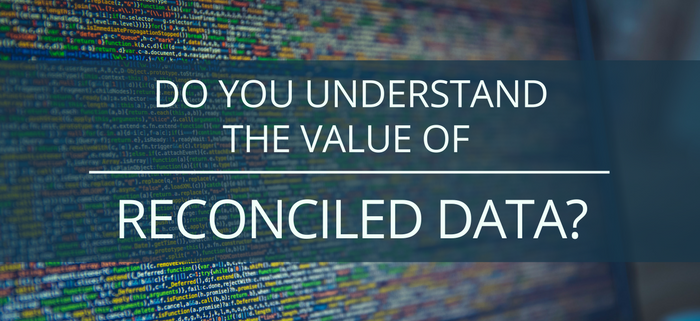Do you understand the value of reconciled data?
Not surprisingly, the creation of regulatory reporting – such as financial reporting – is important for financial institutions. It’s a license to operate. Therefore, it is important to get things done at the right time and with the right quality. But one thing is the importance of financial reporting; another that it has to be repeated, month after month, at the right time and with the appropriate quality. As a result, it should only be natural to focus on optimizing the reporting process. But often that’s not the case.
By Thomas Skou, Partner | 4 November 2016
So why is reconciliation overlooked?
One of the sub processes notoriously overlooked is the reconciliation of data on which reporting is based. Reconciliation in the form of checks ensuring that data – moved from one source system to another – is unchanged. For instance, reconciliation of postings exported from a Capital Market IT system to a general ledger system (ERP system).
So why is reconciliation often overlooked? Because it’s perceived as boring? Or invaluable? We do not know. What we do know, however, is that the whole process is quite complex. But neglecting it altogether will have consequences.
The consequences of financial institutions overlooking reconciliation
The obvious concerns are: Wrong decisions, lack of trust among stakeholders (when errors are detected), fines and penalties from authorities, and more. What is frequently neglected are the costs of handling the continuous return of these errors.
The costs of implementing and maintaining these tools and to drive the entire process are low, compared to the risk and cost of not having a true and fair data basis to report on.
The use of resources, quite often from the whole process chain, deflect attention from employees’ primary tasks that may result in a lack of motivation due to insufficient time to execute their primary tasks. These are all costs that should not be underestimated.
SEE ALSO: The fundamentals of optimizing the accounting reporting process for financial institutions
The bulletproof method
Today, data collection, data processing and data reporting are without any exception based on one or more IT platforms – typically based on a variety of different source systems. The IT platform is not necessarily fully integrated. But often it is integrated to a high degree, as data from one IT system is frequently needed in another IT system.
Successfully developing and maintaining a number of system integrations is not as trivial as it might look from a “desk perspective”. Believing that data always will be “transferred” correctly and on time is a delusion. Of course it can be done! But to rely on it is a major mistake. The only bulletproof method to ensure that data has been “transferred” correctly is to do a reconciliation of the data.
Even small errors in technical terms – e.g. improper number signs – may influence the final reporting in a fatal way. The list of what may cause errors is long, both technically and in terms of processes, and is not particularly relevant in this context. What is important, however, are the consequences of not having a true and fair data baseline to report on – and what to do about it.
SEE ALSO: Known failures in buying Capital Markets software packages
Five steps to consider in establishing the reconciliation process
Luckily, the costs can be avoided altogether! The concept is simple: find the errors as early in the process as possible. One way of doing this is to employ the following five steps:
- Monitor integrations.
- Reconcile data.
- Have a process to ensure that technical breakdowns will be handled.
- Have a process to ensure that the result of the reconciled data is validated and handled, if it does not match.
- Establish a communication process to ensure that the recipients or users of the data are informed about the status of the data. Ask the questions: Do the data have the expected quality, and can we use it?
A number of IT tools exist to exclusively support the reconciliation process – more or less advanced. Spreadsheets may also be used and can be applied in the same way as dedicated applications for automating the entire reconciliations process. The costs of implementing and maintaining these tools and to drive the entire process are low, compared to the risk and cost of not having a true and fair data basis to report on.
So to sum up. There are many valid reasons, and many good tools to help establish the reconciliation process. But maybe even just a review of the existing reconciliation process is enough for you to consider, how to optimize your reporting process?



